Unit 3 The world of science Listening & Speaking 课件(共35张,内嵌视频)2024-2025学年高一英语外研版(2019)必修3
文档属性
| 名称 | Unit 3 The world of science Listening & Speaking 课件(共35张,内嵌视频)2024-2025学年高一英语外研版(2019)必修3 |  | |
| 格式 | pptx | ||
| 文件大小 | 20.8MB | ||
| 资源类型 | 教案 | ||
| 版本资源 | 外研版(2019) | ||
| 科目 | 英语 | ||
| 更新时间 | 2025-05-02 17:17:20 | ||
图片预览

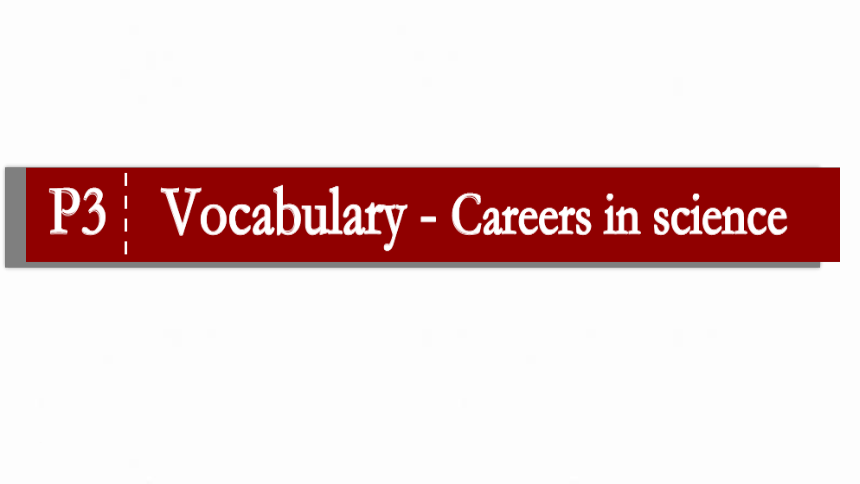

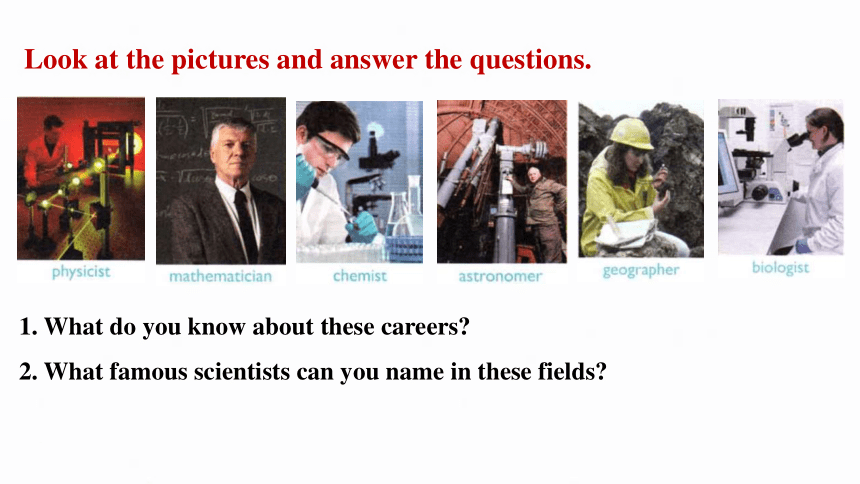
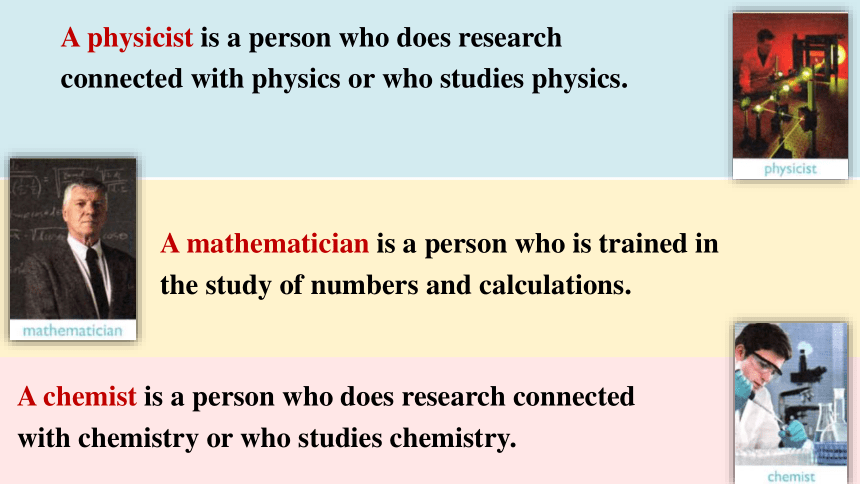

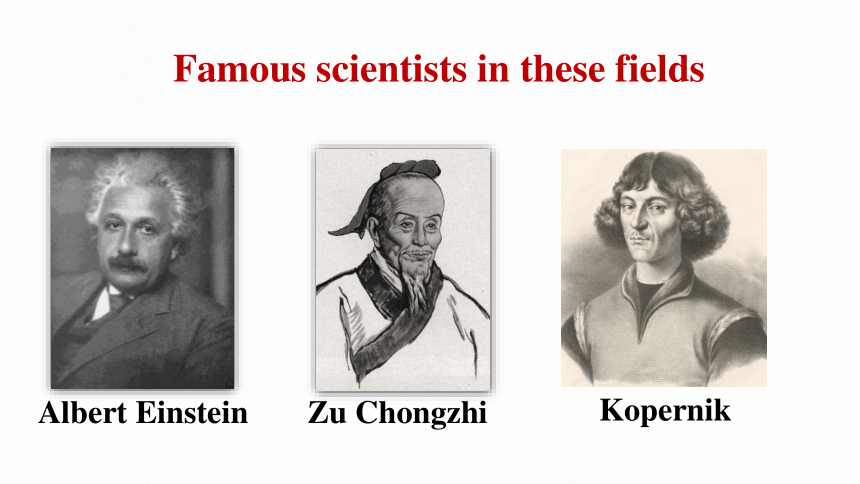


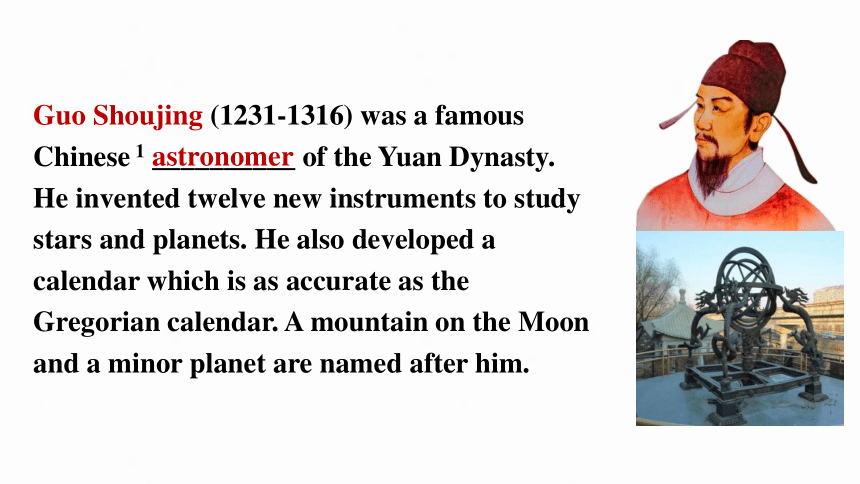


文档简介
(共35张PPT)
Unit 3 The world of science
Listening and Speaking
Understand the main idea of listening materials.
Gather specific details to complete the notes.
Explore general topics related to inventions in daily life.
Learning objectives
Look at the pictures and answer the questions.
1. What do you know about these careers
2. What famous scientists can you name in these fields
A physicist is a person who does research
connected with physics or who studies physics.
A mathematician is a person who is trained in
the study of numbers and calculations.
A chemist is a person who does research connected
with chemistry or who studies chemistry.
Homework
An astronomer is a scientist who studies the
stars, planets, and other natural objects in space.
A geographer is a person who studies geography
or is an expert in it.
A biologist is a person who studies or works in the field of biology.
Famous scientists in these fields
Albert Einstein
Zu Chongzhi
Kopernik
Noun. -ist Noun. -ian
science
scientist
art
novel
piano
society
artist
novelist
pianist
socialist
library
comedy
physic
history
music
librarian
comedian
musician
physician
historian
Learning to learn
Words about different careers in science can be formed by adding -er, -ist or -ian at the end of the words about subjects, eg biology - biologist.
Complete the introductions about different scientists with the words in Activity 4. Pay attention to the language that describes their careers.
astronomer
Guo Shoujing (1231-1316) was a famous Chinese 1 __________ of the Yuan Dynasty. He invented twelve new instruments to study stars and planets. He also developed a calendar which is as accurate as the Gregorian calendar. A mountain on the Moon and a minor planet are named after him.
British 2 ________ Charles Darwin (1809-1882) is best known for his work On the Origin of Species, in which he explains changes in species due to natural selection. His ideas deeply influence our understand- ing of the relationship between humans and nature.
biologist
Li Daoyuan (CA 466-527) was a famous writer and 3___________ of the Northern Wei Dynasty. He did field research across China and studied more than a thousand rivers and streams, along with the landscape, history and culture of the surrounding areas.
geographer
Marie Curie (1867-1934) was a world-famous 4 ________ and was first awarded the Nobel Prize in 1903 for her extraordinary work on radioactivity. She was also regarded as a brilliant 5 ________, and was again awarded the Nobel Prize in 1911 for the isolation of pure radium.
physicist
chemist
Chen Jingrun (1933-1996) was one of the world’s leading 6 ________________. His work on Chen’s Theorem made an important advance towards proving Goldbach’s Conjecture, the greatest unsolved problem in number theory.
mathematician
Think about other careers in science and discuss what interests you most.
I'm interested in the work of a(n)... because...
P40 6
Work in pairs.
◆geologist (地质学家)
◆data analyst (数据分析师)
◆software engineer (软件工程师)
◆environmental engineer
◆pharmacist (药剂师)
Possible words:
View a video to find out what Alzheimer’s disease is (AD) (阿尔茨海默病,老年痴呆症).
Invention stories
Did you know
Alzheimer’s disease is a brain disorder that causes problems with memory, thinking and behaviour.
The majority of people with Alzheime’s are 65 and above.
It is recognised as the most common mental disease among older people, and the number of sufferers is growing. Currently, there’s no cure for Alzheimer’s, but scientists are researching ways to improve the quality of life for people living with the disease.
Alzheimer's disease is a brain disorder that causes problems with memory, thinking and behaviour.
Some inventions also have been made to help people with Alzheimer's.
Now let's listen to a conversation and find out what invention was mentioned.
Listen to the conversation and number the pictures in the correct order.
1
2
3
4
5
Listen again and complete the notes.
a pair of socks designed for people with
Alzheimer’s diseases
a student from New York
His grandfather
A warning
gets out of bed
Tapescript
Check your answers!
1
2
3
4-5
Observe the underlined sentences below. Talk about how the speakers describe the story behind an invention.
They used exclamatory sentences to describe the story. Like “How amazing!” “What a useful invention and caring grandson!”
□ Learning to learn
Exclamatory sentences express strong emotions, such as surprise, shock, joy, emphasis and excitement. These are usually formed with what or how, and in written form usually end with an exclamation mark.
Pair work
Act out the conversation about the invention of the telephone.
Student A: Turn to Page 82.
Student B: Turn to Page 85.
You are going to give a presentation about the invention of the telephone. As part of your research, you speak to Student B who has just read a book about it. Ask him/her questions to find out more information.
Student A
Information you’d like to know:
the inventor
year of invention
the inventing process
the first phone call
other interesting things about the invention
What is the invention
Who was it invented by
Why was it invented Or who inspired the invention
How does it work
…
Useful expressions
You've just read a book about the invention of the telephone.
Student A, who is going to give a presentation on the same topic, asks
you for information.
Student B
Background:
Bell was a teacher at a school for the deaf. He tried to invent a machine to send messages over an electronic wire. This eventually led to the idea of a telephone. Later, with his assistant, he created a device to produce and receive sound waves using electrical signals.
Inventor:
Alexander Graham Bell
Invention created in:
1876
Other information:
Bell never had a telephone in his study, where he wanted to be alone with his thoughts and work.
First phone call:
On 10 March 1876, Bell made the first clear and complete phone call to his assistant, saying, “Mr Watson- come here-I want to see you.”
Telling the story behind an invention
The telephone was invented by ... in ...
When he ...
He later, and finally ...
The first phone call was about ...
It is interesting that ...
Useful expressions
Choose another story of an invention you know and have a similar conversation.
Homework
Unit 3 The world of science
Listening and Speaking
Understand the main idea of listening materials.
Gather specific details to complete the notes.
Explore general topics related to inventions in daily life.
Learning objectives
Look at the pictures and answer the questions.
1. What do you know about these careers
2. What famous scientists can you name in these fields
A physicist is a person who does research
connected with physics or who studies physics.
A mathematician is a person who is trained in
the study of numbers and calculations.
A chemist is a person who does research connected
with chemistry or who studies chemistry.
Homework
An astronomer is a scientist who studies the
stars, planets, and other natural objects in space.
A geographer is a person who studies geography
or is an expert in it.
A biologist is a person who studies or works in the field of biology.
Famous scientists in these fields
Albert Einstein
Zu Chongzhi
Kopernik
Noun. -ist Noun. -ian
science
scientist
art
novel
piano
society
artist
novelist
pianist
socialist
library
comedy
physic
history
music
librarian
comedian
musician
physician
historian
Learning to learn
Words about different careers in science can be formed by adding -er, -ist or -ian at the end of the words about subjects, eg biology - biologist.
Complete the introductions about different scientists with the words in Activity 4. Pay attention to the language that describes their careers.
astronomer
Guo Shoujing (1231-1316) was a famous Chinese 1 __________ of the Yuan Dynasty. He invented twelve new instruments to study stars and planets. He also developed a calendar which is as accurate as the Gregorian calendar. A mountain on the Moon and a minor planet are named after him.
British 2 ________ Charles Darwin (1809-1882) is best known for his work On the Origin of Species, in which he explains changes in species due to natural selection. His ideas deeply influence our understand- ing of the relationship between humans and nature.
biologist
Li Daoyuan (CA 466-527) was a famous writer and 3___________ of the Northern Wei Dynasty. He did field research across China and studied more than a thousand rivers and streams, along with the landscape, history and culture of the surrounding areas.
geographer
Marie Curie (1867-1934) was a world-famous 4 ________ and was first awarded the Nobel Prize in 1903 for her extraordinary work on radioactivity. She was also regarded as a brilliant 5 ________, and was again awarded the Nobel Prize in 1911 for the isolation of pure radium.
physicist
chemist
Chen Jingrun (1933-1996) was one of the world’s leading 6 ________________. His work on Chen’s Theorem made an important advance towards proving Goldbach’s Conjecture, the greatest unsolved problem in number theory.
mathematician
Think about other careers in science and discuss what interests you most.
I'm interested in the work of a(n)... because...
P40 6
Work in pairs.
◆geologist (地质学家)
◆data analyst (数据分析师)
◆software engineer (软件工程师)
◆environmental engineer
◆pharmacist (药剂师)
Possible words:
View a video to find out what Alzheimer’s disease is (AD) (阿尔茨海默病,老年痴呆症).
Invention stories
Did you know
Alzheimer’s disease is a brain disorder that causes problems with memory, thinking and behaviour.
The majority of people with Alzheime’s are 65 and above.
It is recognised as the most common mental disease among older people, and the number of sufferers is growing. Currently, there’s no cure for Alzheimer’s, but scientists are researching ways to improve the quality of life for people living with the disease.
Alzheimer's disease is a brain disorder that causes problems with memory, thinking and behaviour.
Some inventions also have been made to help people with Alzheimer's.
Now let's listen to a conversation and find out what invention was mentioned.
Listen to the conversation and number the pictures in the correct order.
1
2
3
4
5
Listen again and complete the notes.
a pair of socks designed for people with
Alzheimer’s diseases
a student from New York
His grandfather
A warning
gets out of bed
Tapescript
Check your answers!
1
2
3
4-5
Observe the underlined sentences below. Talk about how the speakers describe the story behind an invention.
They used exclamatory sentences to describe the story. Like “How amazing!” “What a useful invention and caring grandson!”
□ Learning to learn
Exclamatory sentences express strong emotions, such as surprise, shock, joy, emphasis and excitement. These are usually formed with what or how, and in written form usually end with an exclamation mark.
Pair work
Act out the conversation about the invention of the telephone.
Student A: Turn to Page 82.
Student B: Turn to Page 85.
You are going to give a presentation about the invention of the telephone. As part of your research, you speak to Student B who has just read a book about it. Ask him/her questions to find out more information.
Student A
Information you’d like to know:
the inventor
year of invention
the inventing process
the first phone call
other interesting things about the invention
What is the invention
Who was it invented by
Why was it invented Or who inspired the invention
How does it work
…
Useful expressions
You've just read a book about the invention of the telephone.
Student A, who is going to give a presentation on the same topic, asks
you for information.
Student B
Background:
Bell was a teacher at a school for the deaf. He tried to invent a machine to send messages over an electronic wire. This eventually led to the idea of a telephone. Later, with his assistant, he created a device to produce and receive sound waves using electrical signals.
Inventor:
Alexander Graham Bell
Invention created in:
1876
Other information:
Bell never had a telephone in his study, where he wanted to be alone with his thoughts and work.
First phone call:
On 10 March 1876, Bell made the first clear and complete phone call to his assistant, saying, “Mr Watson- come here-I want to see you.”
Telling the story behind an invention
The telephone was invented by ... in ...
When he ...
He later, and finally ...
The first phone call was about ...
It is interesting that ...
Useful expressions
Choose another story of an invention you know and have a similar conversation.
Homework
